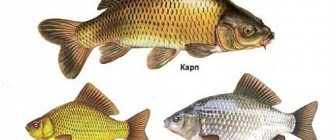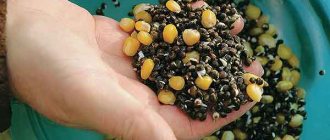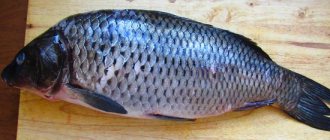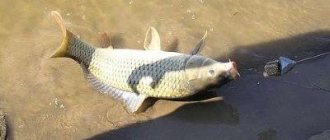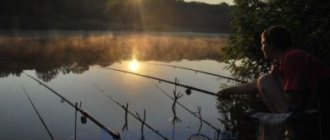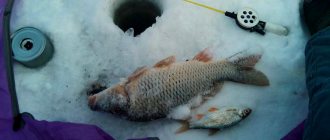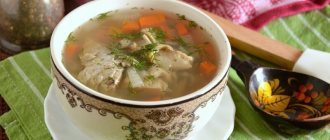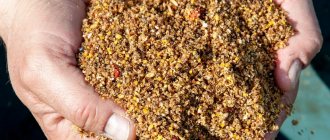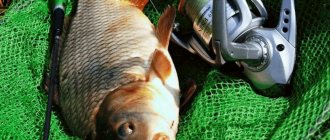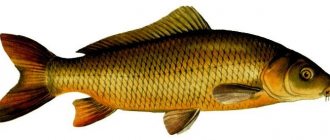Biting calendar
| January | February | March | April | May | June |
| — | — | — | + | +++ | +++ |
| July | August | September | October | November | December |
| +++ | +++ | +++ | + | — | — |
Seasonal Fishing Guides
| The carp begins to peck in the spring, after the winter awakening. As the water warms up, the activity of the fish increases, turning into zhor before spawning. Gathering near spawning grounds, flocks of carp eat not only animal, but also plant food. This is the best time for targeted carp fishing. It is during this period that the largest fish are caught. |
| After spawning, the carp disperses along the river or reservoir. In the summer, you can wait for the fish to bite only after prolonged attachment and feeding. |
| In the fall, as the fish approach the wintering pits, the bite improves. The fish tries to gain fat before a long winter. |
Spawning
Carp can begin breeding at 4-6 years of age. In the middle zone, fish spawn in late spring or early summer, when the water warms up to 18-20°C. For mating, carp choose coastal strips of water bodies, thickets of soft aquatic vegetation, and meadows flooded with melt water. The depth of spawning grounds does not exceed 0.5-1 m.
In the morning you can see 3-4 males swimming in the algae near one female. They periodically jump out of the water and fall noisily onto the water surface. Females lay eggs in 2-3 stages. Large individuals spawn for 10-15 days, and small carp complete their spawning even earlier.
How and what to feed
Bait for carp can be either factory-made or homemade. From industrial ones you need to choose carp and crucian options.
The main components included in homemade bait are millet porridge with boiled or steamed wheat (ratio approximately 1:1).
In addition, corn grits or corn, peas, pearl barley and semolina, oatmeal, hemp or soybean cake are added, if they are not available, then sunflower, as well as compound feed used in poultry farms to feed poultry.
In late autumn, when the water in reservoirs becomes cool, carp descend into bottom holes, bury themselves in the silt and sleep until spring. During the winter they do not eat anything.
It is better to prepare the bait in the evening, since there is usually no time to do this in the morning. After the water boils, add millet grits, stirring continuously, then add wheat, then add corn grits, peas, and pearl barley. Feed, cake, semolina and oatmeal are added last. You can add a little salt, as well as unrefined hemp, soybean or sunflower oil. During the preparation of the bait, it is necessary to mix it thoroughly so that it does not burn. After the porridge is ready, the container in which it was cooked must be covered with a lid and left to cool until the morning.
In the morning, place the cooled porridge on plastic wrap. Then bring gray-blue clay, which can be found near the steep bank of the river; if not, you can use regular clay. The ratio of groundbait and clay should be approximately 2:1, that is, for 2 buckets of groundbait you need 1 bucket of clay, which should be placed on the groundbait lying on plastic film, and then mix it all. The most convenient way to do this is with a shovel. In order for the clay to mix better with the bait, it must be well saturated with water. While mixing, you can add small dry cereals in small quantities: semolina, millet, mixed feed or bran, as well as oat flakes, flour (wheat, breading or oatmeal) and small cake. This is necessary so that the food is better washed away and further carried away by the current.
In the process of filling the feeder, it is a good idea to add crackers of white or rye, lightly toasted bread, preferably in layers, alternating with the main bait. It is best to fill the topmost layer with pieces of cake, which should not pass through the holes of the feeder. It is advisable to add a little unrefined hemp or sunflower oil to the already filled feeder. A few drops of anise oil won't hurt either.
Anglers may wonder why it is advisable to use blue-gray clay? The fact is that this clay gives the train, which is formed during the process of washing the bait out of the feeder, a brighter color than usual, and it (the train) becomes more noticeable to the fish, especially from long distances. For the same purpose, when filling the feeder, you can add powdered milk to the bait. Thus, the likelihood of carp approaching the feeder increases.
Two buckets of porridge cooked according to the recipe outlined above, one bucket of gray-blue clay, plus the recommended additives - this amount of bait is enough to fill 4 feeders, each of which is enough for about 6 hours of fishing, if the current has a speed of 0.3-0 .4 m/s, and the feeder is made of fine-mesh nylon mesh, from which the baby bird is made. It is desirable that the bait, if possible, have the same color, smell and taste as the bait. During the entire period of fishing, you should not change the composition of the bait itself and the technology for its preparation. All this is in order to be less alarming to wild carp, which is one of the most cautious fish.
Carp nutrition
In the spring after hibernation and at the beginning of summer, the carp feeds mainly on young shoots of sedge, water lilies, reeds, pondweed and other vegetation. It actively eats the eggs of spawned fish and frogs. The summer diet of carp shifts towards such animal inhabitants as insects, snails, worms, molting crayfish, leeches, pearl barley. Leaves of aquatic plants also remain on the summer fish menu. But in the fall, the carp completely switches to animal food, eating invertebrates and aquatic insects.
Finding a fishing spot
You should look for carp in lakes and reservoirs near deep holes, flooded riverbeds, and depth changes. Nearby (300-400 m) there should be areas overgrown with algae. This is where the fish come out to feed. He likes to hide in the rubble of snags, bushes, and in the remaining stumps from the former forest. But the depth in such places must be at least 3 m.
In rivers, carp must be caught in quiet, deep pools with a slow or reverse current. Nearby there should be grassy sections of a river or oxbow where fish feed.
Groundbait and bait
For targeted fishing for carp, bait is not always enough to attract fish to the fishing point. Privada works more effectively. If you supply food for 3-4 days after sunset and throw in bait during fishing, then in this way you can train the carp to feed in the fished area. An even greater effect is obtained when bait and bait are taken down into the pit in which the carp are kept.
Cake, steamed grains, porridge, boiled potatoes, chopped shells and worms are used as bait and bait.
The best bait mixtures that you can buy in the store are Trapped, Sensas, Dunaev fruit flavors.
Where to look
Carp, unlike its closest relative carp, often floats on the current. True, it still doesn’t like fast flows of water: carp prefer warm areas with slow flows. However, reservoirs with stagnant water may well bring a good catch.
Since the carp tries to stay close to natural shelters, special attention should be paid to places with a depth of 2 meters and unevenness on the bottom. Another favorite place for carp is in holes near flooded trees.
Usually it feeds at the exits and entrances to pits - it is convenient for the fisherman to look for it here, since small things do not bother you in these areas. Carp can also be found on the border of aquatic plants with a depth of about 2-3 meters.
Depending on the weather, time of day and situation on the reservoir, carp can go to shallow waters, feed along steep banks and shores with bushes and trees, and near islands.
But it is worth understanding that the carp bite is stable only in stable, constant weather. If the weather is unstable (the temperature changes, it gets very cold), then the carp stops pecking altogether. But a light breeze or mushroom rain in consistently warm weather is quite conducive to carp biting.
Read: Spring fishing. Tactics and techniques for catching carp
By the way, the best time for catching carp at this time is morning and evening dawn. Only in autumn does its biting time shift to daytime hours. However, in moderately warm weather, carp can peck all day long.
Fishing methods
Feeder is the most common sports method of catching carp. Allows you to do targeted feeding even in places very remote from the shore and wait for a bite from wary fish. Follow the link for a guide to spring and summer fishing.
Carp fishing methods are a whole culture of catching cautious large specimens of carp, which can easily include the wild host of flowing water bodies - carp.
Non-sporting bottom gear - fishing methods in which the sensitivity of the gear is greatly reduced and does not allow active hooking when biting (the emphasis is on self-hooking of the fish); methods in which the fish is hooked by chance: top, nipple, spring, bottom fishing rod from a spinning rod.
Jig fishing with edible rubber is an exotic method that nevertheless allows you to catch active carp with a fairly high regularity.
When carp are caught, carp will bite, the best days for biting
Each fisherman may have his own fishing preferences, not only for catching fish with certain gear, but also for the fish itself. Some people like to fish for river fish, others prefer to catch lake fish, just like with predatory and peaceful fish.
We will talk about carp, biting and carp fishing in winter, spring, summer and autumn 2021, the calendar of favorable biting days, in which months carp (carp) fishing is most realistic and the best catch.
In the carp and carp biting calendar with a table of months for 2021, the fisherman will learn about the favorable days of winter, spring, summer and autumn for carp fishing, when the carp are biting and the carp is best on the hook, something else that concerns fishing...
A fisherman who is going fishing, especially for carp, needs to know what the carp bite will be like, which the 2021 fish (carp) biting calendar will help you find out, which contains all the information about favorable and unfavorable fishing days, taking into account the changing phases of the Moon, which is very it is important that you yourself know very well and understand this issue.
For fishermen, we present a calendar of carp and carp biting days in winter, spring, summer and autumn 2021, a forecast for today and tomorrow, all weeks and months with a table in which they will find out which of them will bite, and when the catch can be missed count, and it is best to do some other work, solving other, more important matters.
We need a lunar calendar of carp and carp biting for today, tomorrow, every week of winter, spring, summer and autumn 2021, with a fishing forecast, when it will bite, for many reasons, and knowing when the fish bites and will be active is important for the fisherman, because fishing and its main goal is still to catch a fish, a decent catch of fish, although spending time in a quiet place in the lap of nature is also a good reason to go fishing, even if it turns out to be without the desired result, for many it is also a great pastime.
Fishing can be different, open and closed, winter and summer, just as fishermen are different, some like to fish with a fishing rod, some prefer spinning, some are attracted to a rubber band or a girder, and so on. In our country there are countless fishermen, both almost professional ones who cannot spend a free day without fishing and weekend fishing, and amateurs who from time to time go fishing to a pond or river, just for the sake of a couple of fish in the fish soup by the fire.
It doesn’t matter who you are, an avid fisherman or an amateur fisherman, you definitely need a lunar fishing calendar 2021, fisherman and carp fishing, successful fishing days, so that you can know exactly when and on what favorable day or period, there are increased chances of catching one or other fish, to receive for your hobby not only moral, but also a certain material satisfaction in the form of a caught catch, which, of course, is also extremely important, probably even relevant in our difficult times.
In our life, everything is interconnected, sometimes even the smallest detail plays a decisive role, which means that in order to achieve the goal we have set for ourselves, we simply need to take such nuances into account.
This could be the case for a fisherman in 2021 - favorable days for biting fish, catching carp and carp in winter, spring, summer and autumn, forecast for today and tomorrow, weeks of months, that is, favorable in terms of the location of the night star and the phases of the Moon, which is very important.

